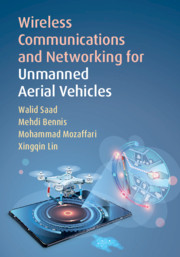Refine search
Actions for selected content:
2076 results in Aerospace engineering
8 - Cooperative Communications in UAV Networks
-
- Book:
- Wireless Communications and Networking for Unmanned Aerial Vehicles
- Published online:
- 31 March 2020
- Print publication:
- 02 April 2020, pp 181-206
-
- Chapter
- Export citation
Acknowledgments
-
- Book:
- Wireless Communications and Networking for Unmanned Aerial Vehicles
- Published online:
- 31 March 2020
- Print publication:
- 02 April 2020, pp xii-xii
-
- Chapter
- Export citation
1 - Wireless Communications and Networking with Unmanned Aerial Vehicles: An Introduction
-
- Book:
- Wireless Communications and Networking for Unmanned Aerial Vehicles
- Published online:
- 31 March 2020
- Print publication:
- 02 April 2020, pp 1-11
-
- Chapter
- Export citation
7 - Resource Management for UAV Networks
-
- Book:
- Wireless Communications and Networking for Unmanned Aerial Vehicles
- Published online:
- 31 March 2020
- Print publication:
- 02 April 2020, pp 145-180
-
- Chapter
- Export citation
Contents
-
- Book:
- Wireless Communications and Networking for Unmanned Aerial Vehicles
- Published online:
- 31 March 2020
- Print publication:
- 02 April 2020, pp vii-xi
-
- Chapter
- Export citation
3 - Aerial Channel Modeling and Waveform Design
-
- Book:
- Wireless Communications and Networking for Unmanned Aerial Vehicles
- Published online:
- 31 March 2020
- Print publication:
- 02 April 2020, pp 22-67
-
- Chapter
- Export citation
5 - Deployment of UAVs for Wireless Communications
-
- Book:
- Wireless Communications and Networking for Unmanned Aerial Vehicles
- Published online:
- 31 March 2020
- Print publication:
- 02 April 2020, pp 90-122
-
- Chapter
- Export citation
Index
-
- Book:
- Wireless Communications and Networking for Unmanned Aerial Vehicles
- Published online:
- 31 March 2020
- Print publication:
- 02 April 2020, pp 279-282
-
- Chapter
- Export citation
10 - Security of UAV Networks
-
- Book:
- Wireless Communications and Networking for Unmanned Aerial Vehicles
- Published online:
- 31 March 2020
- Print publication:
- 02 April 2020, pp 240-257
-
- Chapter
- Export citation
2 - UAV Applications and Use Cases
-
- Book:
- Wireless Communications and Networking for Unmanned Aerial Vehicles
- Published online:
- 31 March 2020
- Print publication:
- 02 April 2020, pp 12-21
-
- Chapter
- Export citation
9 - From LTE to 5G NR-Enabled UAV Networks
-
- Book:
- Wireless Communications and Networking for Unmanned Aerial Vehicles
- Published online:
- 31 March 2020
- Print publication:
- 02 April 2020, pp 207-239
-
- Chapter
- Export citation
Dedication
-
- Book:
- Wireless Communications and Networking for Unmanned Aerial Vehicles
- Published online:
- 31 March 2020
- Print publication:
- 02 April 2020, pp v-vi
-
- Chapter
- Export citation
References
-
- Book:
- Wireless Communications and Networking for Unmanned Aerial Vehicles
- Published online:
- 31 March 2020
- Print publication:
- 02 April 2020, pp 258-278
-
- Chapter
- Export citation
Frontmatter
-
- Book:
- Wireless Communications and Networking for Unmanned Aerial Vehicles
- Published online:
- 31 March 2020
- Print publication:
- 02 April 2020, pp i-iv
-
- Chapter
- Export citation

Wireless Communications and Networking for Unmanned Aerial Vehicles
-
- Published online:
- 31 March 2020
- Print publication:
- 02 April 2020
Endmatter
-
- Book:
- Wind Turbines
- Published online:
- 08 February 2020
- Print publication:
- 20 February 2020, pp 1-2
-
- Chapter
- Export citation
Preface
-
- Book:
- Wind Turbines
- Published online:
- 08 February 2020
- Print publication:
- 20 February 2020, pp xiii-xvi
-
- Chapter
- Export citation
Frontmatter
-
- Book:
- Wind Turbines
- Published online:
- 08 February 2020
- Print publication:
- 20 February 2020, pp i-iv
-
- Chapter
- Export citation
8 - Rotor Blade Technology
-
- Book:
- Wind Turbines
- Published online:
- 08 February 2020
- Print publication:
- 20 February 2020, pp 174-209
-
- Chapter
- Export citation
Acknowledgements
-
- Book:
- Wind Turbines
- Published online:
- 08 February 2020
- Print publication:
- 20 February 2020, pp x-xii
-
- Chapter
- Export citation
